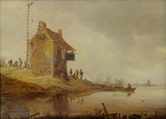
Most expensive
Toll Tower on the Merwede by Jan van Goyen, 1645.
This river scene is painted in Van Goyen’s characteristic style. He painted many large cityscapes on commission, including View of Dordrecht and View of Leiden, both on display in museums in those cities. More than 1,000 paintings and 800 drawings by him are known.
What do we see?
On the left is the riverbank with what appears to be the square brick toll house of the Rotterdam Admiralty, where convoy tax and licence fees (as customs duties were then called) were collected. A man with a rifle is on the balcony. Below the balcony, four people (inspectors and boatmen of the watch) are talking. To the right of a spur on the riverbank is a rowing boat that was used by the watch and boatmen to check transport documents and goods aboard passing ships. In the distance, you can see Dordrecht with its stubby church tower. To the left of the toll house, three people are standing near a wooden climbing mast from which a brazier hangs; it is light beacon for the boatmen. Fire pots were first used for this purpose, and later oil lamps
The painting is signed with initials and dated – VG 1645 – on the left near the wooden stairs. On the riverbank in the foreground is a fish box (for live fish or crabs).
Fun fact
Van Goyen was the father-in-law of the famous painter Jan Steen. The domestic scenes Steen painted were based on the Van Goyen family home where he lived.
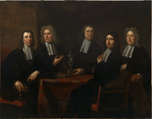
Most complicated history
The Governors of the Amsterdam Guild of Gold- and Silversmiths by Juriaen Pool II, 1701. Before the Assay Office was established, gold and silver were inspected and hallmarked by the guilds. Master gold- and silversmiths were obliged to join the guild of their city; they paid membership fees and their maker’s mark was stamped on a guild plate. If silver and gold items were of the correct purity level, they were stamped with the city’s mark.
Five governors of the Amsterdam guild of gold- and silversmiths’ guild are sitting at a table with an oriental carpet. In front of them are a goblet, candlestick, sugar caster and wooden box. This could be a coin-weight box or a casket containing touch needles (instruments for testing silver and gold). The painter’s name and the year are inscribed on the back of the chair in the foreground. That year tells us which individuals are depicted here: Dirk Schelte, Joannes de Vicq, Mattheus Weyland, Hendrik de Hondt and Gerard de Lange – but who is who is not known.
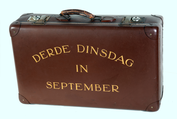
Most traditional
Lieftinck’s budget box
On 17 May 1946, parliamentary elections were held again for the first time since World War II. Barely two months later, the Beel I cabinet took office and Prof. Piet Lieftinck became finance minister.
On the third Tuesday of September, he presented the government’s budget to parliament.
Lieftinck was familiar with the British tradition of using red boxes (briefcases) to carry government documents and, as the new minister, he introduced his own tradition. An official was sent out to buy a briefcase and found one in a shop on Laan van Meerdervoort in The Hague for 3.75 guilders. ‘Third Tuesday of September’ (budget day) was stuck on it in gold foil letters. But the letters kept wearing off and around 1955 the text was painted on with gold paint – a more long-lasting solution.
The tradition
From its introduction in 1946 up until 1964, this briefcase was used on Prinsjesdag (the state opening of parliament) to carry the national budget and the budget memorandum (miljoenennota in Dutch) to the States General. After the king (or queen) delivers the Speech from the Throne in the Ridderzaal, the ceremony moves to the chamber of the Lower House. The Speaker of the Lower House receives the national budget from the Minister of Finance on behalf of the States General. At that time, the sections of the national budget are not yet bound: an orange ribbon is tied around each section, one for each minister. Nowadays, not all the sections of the budget can fit into the white goatskin leather briefcase that’s been used since 1964. For the sake of tradition, a few sections with orange ribbons are put in it. All the sections are made available online that same day. Since 1887, the opening of the new parliamentary year of the States General has taken place on the third Tuesday of September. Before then, the tradition was the third Monday.
Reconstruction
Piet Lieftinck is remembered for being a very frugal minister, as he had to make – and keep – the Netherlands financially sound during the Reconstruction period after World War II. There are many cartoons in our collection in which he is immediately recognisable with his slightly domed head and round glasses. The Apeldoorn firm LIWA made a Lieftinck piggy bank that is also a kind of cartoon. Perhaps it made people feel good to smash open Lieftinck’s earthenware head! Fortunately, they had first applied his thriftiness to their own budget.
Fun fact
On 18 September 2015, Minister Jeroen Dijsselbloem personally returned Lieftinck’s budget box to the museum. He had borrowed it for budget day that year because he saw himself facing a similar task to Minister Lieftinck’s: to spend limited resources frugally. Dijsselbloem also brought along the current budget box and placed both boxes to mark the opening of the exhibition Prinsjesdag en de Miljoenennota.
Fun fact
Finance ministers have departed from existing traditions on more occasions.
Onno Ruding, for instance, presented a budget memorandum on a microfiche in a mini-case. Jan Kees de Jager, who had founded an IT company before becoming minister, presented his first budget memorandum to the Lower House on an iPad with a matching case.

Least woke
Customs Dream is a painting with a strange undertone; it assumes that customs officers dream of being allowed to grope women under the pretext of searching them. Not a very woman-friendly thought...Or is it? Aad de Haas also painted a series of erotic works showing men touching women in explicitly sexual ways. We do not know if the customs officer in the painting asked for permission, which is why we do not find the painting at all woke. Even if it’s just a dream, it’s an abuse of power.
The dream
A hazily painted customs scene with a mystical atmosphere. On the left, you see two customs officers in uniform. A woman is standing in front of the taller officer. Another woman is waiting her turn with her bag on her lap. Near the seated woman is a skinny dog with a snout so pointed it’s more like a bird’s beak.
Aad de Haas painted many such fantasy animals. In the niches in the background are statues representing Justice and the Law. On a plinth on the left is a statue of the Dutch Lion. The scene is encircled by a kind of stage curtain. The positioning of the depicted figures also looks rather like a play. The title Customs Dream suggests that this painting represents the secret wish of a customs officer, given that touching women was strictly forbidden. If no women were working at the customs post, the wife of the chief officer would be appointed a temporary customs assistant. In that capacity, the wives were paid a fee by the state for each woman they searched.
Fun fact
Today, it is a woman – Nanette van Schelven – who holds the top job at Customs.
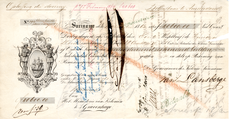
The Strangest
Bill of exchange on the abolition of slavery
The Netherlands was comparatively late in abolishing slavery: 1863 – two years before the United States, but 30 years after the UK. The owners of enslaved people received compensation of 300 guilders per person for the loss of free labour. The enslaved persons themselves got nothing at all and were even forced to continue working on plantations for a pittance for 10 more years under state supervision.
What does it say?
The bill of exchange is signed by the governor of the Colony of Suriname, Van Lansberge. The amount is 40,600 guilders. The bill of exchange passed through several hands. The signatures on the back include the colonial paymaster and receiver H. Charlouis, and E.J.F. van der Schrieck and J.J. van der Schrieck of Amsterdam on behalf of the plantation De Goudmijn. J.C. van de Watering’s signature confirms that stamp duty amounting to 28.29 guilders was paid on 6 August 1864. The imprint and stamp image of the embossed stamp are visible on the back of the wisselbrief, along with the curved text: Ministerie v Kolonie Suriname zegel 1863.
Who?
The first recipient was Carl Reinhard Berner for the plantation La Tourtonne, near Paramaribo. In 1844, he appears in the civil registry of Paramaribo as a merchant and the husband of Ester Adolphina van Maarsen. He lived on Watermolenstraat with their two children: a 4 year old, a 7-month-old baby and another 7-month-old child with a different surname (Jantje van Drumont) plus a white woman aged 20. Probably this woman, Nanny van der Mee, was a relative as she is listed without a profession. They lived with seven enslaved women.
Berner died on 9 November 1868, aged 66.
Where?
La Tourtonne was a plantation of some 1,500 acres, growing coffee and cocoa in Boomskreek.
Alexander Lavaux’s 1758 map shows a La Tourtonne plantation (No 5).

The Ugliest
Tromp hall bench
There is no arguing about taste: some find this hall bench beautiful, others think it’s really ugly. It was made during what art experts in the Netherlands have called the ‘ugly period’ since an exhibition at the Rijksmuseum in 1995. The period in question was from about 1835 to 1895, when all kinds of styles from the past were mashed up and reused.
The bench has neo-classical and neo-Renaissance parts with a seascape that imitates the style of the 17th century and a portrait that is a copy of a 19th-century original in the Rijksmuseum. The bench itself dates from the early 20th century. The latest restoration even added a 21st-century element: the flag at the top right had disappeared and has now been recreated.
Fun fact
The hall bench is an invented tradition creation: something new that draws on centuries-old traditions. The bench tells the story that the person depicted, Admiral Cornelis Tromp, was given the bench as a gift for part in the victory at the Battle of Öland in June 1676. Tromp led a combined Dano-Dutch fleet against the Swedish navy to gain control of access to the southern Baltic Sea as well as control of the toll levied for passage through the Sound (Sound Toll). Dutch merchants earned great wealth from the Baltic trade in grain, timber, wool and furs. However, by the time the bench was made, Cornelis Tromp had been lying in the Tromp family crypt in Delft for two centuries.
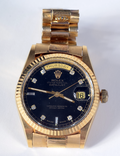
The Cheapest
Fake Rolex
A counterfeit watch is many times cheaper than an authentic brand-name one, but if you get caught, the costs can be quite high. The Dutch are ordering more and more products via the internet and apps that sell things extremely cheaply. The biggest flow of counterfeit goods enters the Netherlands through shipping containers.
Ultimately, this ‘Rolex’ was not collected by the purchaser. He tried to avoid the fine for this counterfeit product by claiming the watch was genuine. When he was then faced with the import duty (at the time 12% of the catalogue value of about 12,500 euros), he chose to forgo the watch and pay the fine instead.
Law
Sometimes trademark infringement only causes economic damage, but fake products can also result in damage to health and safety, for example, in the case of counterfeit medicines, helmets or car parts.
The Economic Offences Act protects intellectual property. A product may not be counterfeited just like that. To this end, Customs works with the Ministry of Economic Affairs and companies that are the victims of product counterfeiting.
Customs also works with other parties: the Ministry of Health, Welfare and Sport to check medicines; the Ministry of Agriculture, Fisheries, Food Security and Nature to monitor food quality; and the Police, Royal Dutch Marechaussee and Aliens Police in enforcing the Weapons and Ammunition Act, investigating drug trafficking and fighting organised crime.

The Smallest
Deventer toll token
Apart from being the smallest object in the museum, this toll token is also one of the oldest. It dates from between 1012 and 1022, making it over 1,000 years old! Deventer is itself one of the five oldest cities in the Netherlands. It was first mentioned in a written source in the 9th century. This small token allowed travellers to prove that they had paid the toll. At that time, most people were illiterate and tokens like this could be easily understood by everyone.
Deventer fell under the authority of the bishop of Utrecht, a vassal of the German emperor. When the bishop fled from the Vikings in 856, he set up a substitute court in Deventer, turning the city into a religious centre. It wasn’t until the 10th century that the bishop then in office would return to Utrecht. This drawing by A.H.J. Meijer shows the Church of Our Lady on the left, built in 937 by Bishop Balderic of Utrecht. The church on the right was attached to it and later expanded to become St Lebuinus’s Church. The Church of Our Lady is no longer standing, but visitors from the time of the toll token would have prayed there for a safe journey.
In the Middle Ages, Deventer was an important city. The first trade alliance of German cities, the Hanseatic League, began in the mid-12th century and was later expanded to include 200 cities spread across Europe. Through cooperation and joint travel, goods could be transported more safely. Naturally, Deventer became an important link along the Hanseatic route thanks to its location on the IJssel and its natural harbour. A small piece of the Netherlands can still be seen on the map from the late Middle Ages that shows the northern Hanseatic area.
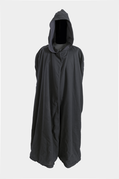
Most Exciting
Night cloak
When prices are different across borders, people will always try to make money. You might think, ‘Why go to all that trouble for butter?’, but smuggling actually happened on a massive scale. Butter was cheaper in the Netherlands than in Belgium, margarine was cheaper in Belgium. Until about the 1980s, the emphasis in the Netherlands was on nutritious cheap food; the cookbook Aaltje, the Perfect and Frugal Kitchen Maid was reprinted 18 times! Belgians were more like gourmets, with an appreciation of fine food. These cultural differences made smuggling back and forth very lucrative.
Customs officers were transferred every three years to prevent them from becoming overly familiar with village communities and likely to turn a blind eye to local smuggling.
Customs officers went out into the open along smuggling trails and protected themselves from the cold with sheepskin sleeping bags and thick woollen cloaks. They were not allowed to smoke to keep themselves awake, as smugglers would be able to see the bright spots of cigarettes from far away. The shift supervisor (the boss) cycled past at night to check that his men had not fallen asleep.
In the early 20th century, smuggling was exciting with smugglers walking in groups across the moors, sacks hanging over their shoulders. But things quickly turned grim when deaths occurred. Smugglers started using big American cars in the 1950s. When confiscated by Customs, these cars were eagerly reused by customs officers to chase down smugglers. Both sides tinkered with caltrops to hinder each other, and their use resulted in serious injuries.
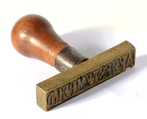
Most Boring
Stamps
A former Tax Administration official once said: ‘If a civil servant has to write something down more than once, he’ll have a stamp made for it.’ Stamps are the first step towards automation: human actions are standardised, automated, so that they require as little effort as possible.
Our collection has many stamps from 1800 to the present day. The oldest stamps date back to the Batavian-French period. The French occupation brought bureaucracy with it, including the establishment of the Tax Administration, the Land Registry, the Assay Office and the Civil Registry. Governing a country centrally requires centrally controlled administration. Seals and stamps were used to validate documents.
Tax forms, stamps...at first glance, boring objects – but they can still teach us a lot about the past. What was taxed? What was important to people?
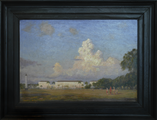
Most Misguided
The painting Ministry of Finance on Waterloo Square in Batavia by Carel Lodewijk Dake Jr, shows the white ministry building with palm trees at the front, in a sunny, tropical world. The foreground on the right features four women in colourful sarongs. The painting is signed and dated in the lower right corner. Officials from this ministry presented this painting to C.W. Bodenhausen, Director of Finance in the Dutch East Indies, as a farewell gift on 4 September 1926.
Fun fact
The official dress that Bodenhausen is wearing in the photo is kept at the museum. Despite being a tropical uniform with white trousers, it is made of thick scratchy wool.
The fantasy world of ‘Our Indies’ as depicted in this painting is exactly how the Dutch imagined life in the colony. In reality, Batavia had a rigid class system, racism was legally enshrined and by the 1930s, society was segregated to its core. There was a lot of local resistance, but it did not register in the ‘motherland’. Indonesian freedom fighters were instead portrayed as a band of thieves.
More about the artist
This work was painted by Carel Lodewijk Dake Jr. He was born in Brussels in 1886 and died in Jakarta in 1946. From 1912, he worked in various places in what is now Indonesia.
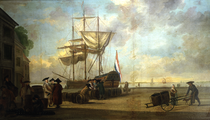
The Biggest
The largest exhibit in the museum is the painting View of the Port of Dordrecht by Dirk Kuipers. It shows the port of Dordrecht and activities on the quay involving a ship that has just arrived. Officials from Convoy Tax & Licence Fees (the forerunner of Customs) are inspecting the cargo. The barrels probably contain wine that is being gauged. The antique measuring instruments depicted are also on display in the museum.
Dordrecht native Dirk Kuipers painted this canvas around 1760. It is quite possible that the painting was originally made as a wallpaper for a wealthy merchant’s house. Such interior decoration was very fashionable in the 18th century – for those who could afford it. Wallpapers were set into wainscoting: wooden panels were placed underneath and the wallpaper reached up to the ceiling. It made it seem as if the painting was the actual view from the room.
In the 18th century, these types of optical illusion (known as trompe l’œil) were highly sought after. The wallpapers created a certain illusion in a room. Often, a painted floral arrangement or a mirror was placed above a fireplace to create the illusion of space. Another type of trompe l'œil was to have panels painted in grey tones placed above doors, which was meant to create the illusion of carved marble or gypsum plaster.
Several landscapes by Dirk Kuipers have survived. One example is a watercolour featuring various birds against a fantastical background that is in the Rijksmuseum collection.
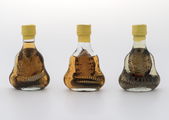
Most Horrific
Customs is regularly confronted with animal abuse and the criminal trafficking of protected animals – dead and alive. Since 1 June 1976, customs officers have also been able to take action against this. At that time, the CITES treaty came into force. CITES stands for the Convention on International Trade in Endangered Species of Wild Fauna and Flora. The treaty thus applies to both animals and plants. An endangered status can change if conservation programmes are successful. Unfortunately, the opposite usually happens: since 1970, two-thirds of vertebrate animals have been wiped out worldwide.
What is the connection between Customs and Freek Vonk?
Luckily, there are many public and private organisations that work together to track, expose and combat this so-called wildlife crime, such as the Wildlife Justice Commission, the World Wildlife Fund, the No Wildlife Crime Foundation of Prof. Freek Vonk, and of course Customs, the police, and the Netherlands Food and Consumer Product Safety Authority. Customs performs checks at the Netherlands’ external borders with the European Union and the Schengen Area to prevent protected animals and plants from being smuggled into (and through) the country.
How can you help?
If you want to transport a protected animal or plant across a border, you need a permit. For instance, you can get a permit for antique animal products or zoo animals. However, it’s better if you leave products and animals where they are.
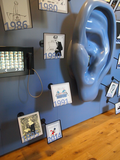
The Funniest
Tax humour
What one person finds funny, may not be at all funny to someone else. At the museum, we showcase a selection of cartoons that are occasionally changed. The criterion is that it should be clear at first glance what a cartoon is about.
Many drawings mock high taxes: a Dutchman bearing a heavy weight is squeezed like a lemon or milked like a cow. Often, finance ministers are depicted as a kind of Grim Reaper or the stereotypical usurer out to take money from ordinary people.
The Dutch childcare benefit scandal also led to many cartoons. No one was laughing at the injustice done to the victims. But the resignation of the Rutte III cabinet on 15 January 2021, after the brutally harsh report on this scandal, is depicted quite humorously. Inside a daycare centre called The Small Inner Court, Prime Minister Rutte and Finance Minister Hoekstra are portrayed as toddlers in diapers.
The childcare benefit scandal and the benefit restoration scheme have already given rise to many cartoons. The snail’s pace at which benefit restoration and compensation is taking place is a cartoonist’s dream.
More about the artist
Eliane Gerrits studied at the St Joost School of Art & Design in Breda, the Free Academy in The Hague and the AKI Academy for Art & Design in Enschede. She works for various clients: NRC Handelsblad, EW Magazine, the Huffington Post, Gouden boekjes, and the VPRO guide. Gerrits also paints, takes photographs and creates non-commissioned works.
Which cartoon do you think is the funniest?
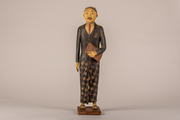
Most colonial
Colonial civil servant
How this Indonesian civil servant looks reflects his ambivalent position in the Dutch colonial administration. He is carrying a briefcase and wearing a watch chain and European clothes combined with a sarong, slippers and an iket (traditional headwear). Indonesians who participated in the executive administrative apparatus in the Dutch East Indies received a Western education. They had a salary and prestige in the colonial class system. The divide-and-rule principle was successful. Without the involvement of local tax officials, it would have never been possible to govern such a vast area so efficiently.
An enormous amount
The total of all registered tax revenues in the Dutch East Indies from 1848 to 1940 amounted to 25,836,314,430 guilders. Everything the Dutch government collected before 1848 comes on top of this, but those revenues are not well documented. The colonial government also had expenditures, but these are not taken into account because they benefited the Dutch administration rather than the Indonesian people. For example, the Dutch built a railway – not to make travel in Java (more than three times the size of the Netherlands) easier – but to transport timber from the jungles to the port.